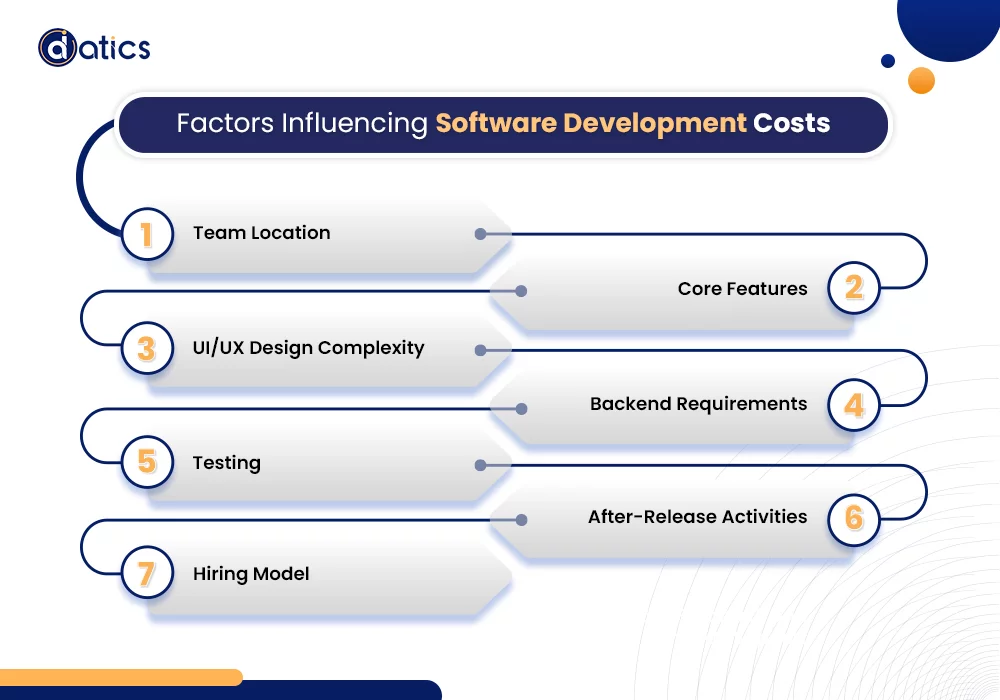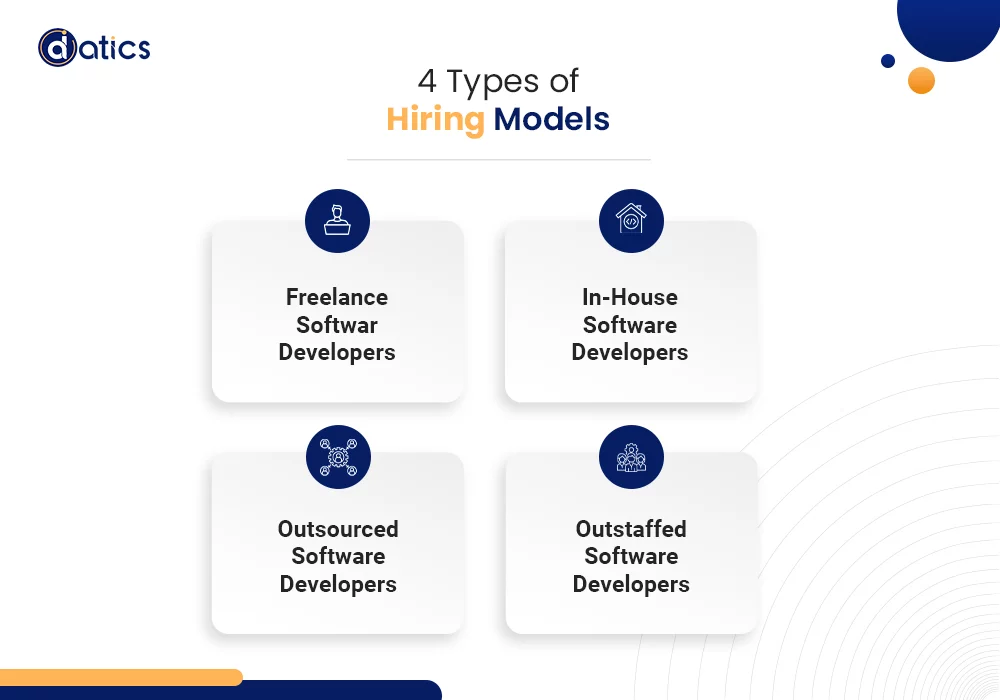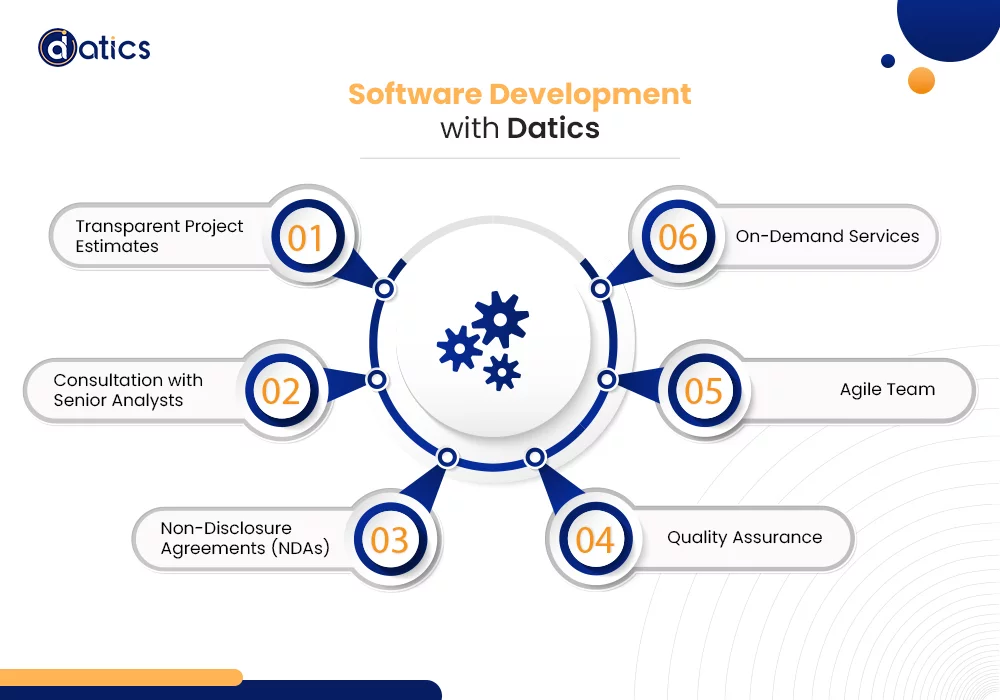
© 2024 | All Right Revered.
A detailed guide to estimate the cost of software development in 2024 for your business.

Founder & CEO | Datics AI
A data scientist turned entrepreneur, on a mission to revolutionize tech ecosystem and empower companies in their digital transformation journey.

Imagine a game-changing software idea ready to revolutionize your business. The burning question: “What’s the price tag to make it happen?”
This is a question that occupies the thoughts of every founder, scale-up, or established enterprise when diving into the world of software development.
However, there’s a twist—there’s no universal answer to this question. Whether you’re envisioning a sleek mobile app or tackling the challenges of crafting a comprehensive enterprise system, the journey to bring your idea to life often shares surprising similarities in terms of both time and financial investment.
The ever-increasing cost of software development compels businesses of all sizes to explore innovative solutions to optimize their development lifecycles and budgets.
Leveraging our extensive experience spanning over five years in the realm of software development, the team at Datics AI has gained invaluable insights into the art of estimating project costs, regardless of their scope.
In this article, we’re here to act as your compass, guiding you through the intricacies of cost assessment. We’ll shed light on the key factors that influence costs, delve into different pricing models, and demystify the estimation process itself. If you’re keen on unraveling the complexities of software development costs, then keep reading, because we’re here to provide you with crystal-clear clarity.
This section provides a general roadmap to navigate the cost of software development in 2024. Keep in mind that these figures serve as a starting point, as the true cost of software development hinges on your project’s unique requirements.
Determining the cost of software development in 2024 isn’t a straightforward equation. While online consensus and estimates point to a price range between $50K and $250K, the reality is far more intricate. A variety of complex factors play a role in calculating the precise cost of software development.
While these ballpark figures can offer a rough idea of what you might expect to spend, the true art of professional project estimation transcends these generalities. It hinges on a meticulous examination of your project, aligning it with your business objectives, approved schedules, budgets, and the timeframes you’ve set for its completion.
To shed light on the components that shape your software development expenses, let’s look into the primary cost influencers below.
The size of a company carries significant weight in determining software development costs. Smaller companies often require simpler software tools, while larger multinational corporations (MNCs) deal with vast amounts of data and intricate operations, necessitating multi-tier software solutions.
Let’s explore the different company sizes and how they influence software development costs:
Startups, the fresh faces of the business landscape, are driven by innovation. They often focus on unique products or services that have yet to make their mark. Motivated by a desire to address specific user needs, startups seek custom-tailored solutions.
To gauge the viability of their digital offerings, startups collaborate with software development firms to create prototypes or Minimum Viable Products (MVPs). MVPs provide essential functionality at a lower cost compared to full-scale solutions. Typically, startups can develop an MVP in a few months, requiring 600 to 800 development hours. Costs vary based on the development team’s location but generally fall within the range of $10,000 to $100,000.
This difference in complexity directly translates to a variation in the cost of software development.
SMEs, driven by the need for increased efficiency, place a strong emphasis on scalability to accommodate their growth trajectory. They require solutions of moderate complexity that cater to a variety of unique business needs. These solutions often encompass features such as business process automation, integrations, data management, and communication tools.
On average, software development for SMEs spans a timeline of 3 to 6 months and necessitates the concerted effort of the entire development team. SMBs tend to allocate more substantial resources to software development costs, with values ranging from $50,000 to $500,000 or higher, contingent upon the project’s scale and complexity.
Established enterprises juggle numerous internal operations and a sizable workforce. Consequently, their enterprise software needs are vast, encompassing tasks like data analysis, sales management, resource planning, and more. These solutions are characterized by complexity, advanced features, scalability, and robust integration capabilities.
Tailored enterprise software often must comply with regulations and boast formidable security measures. Due to their intricacy, large-scale solutions may require over 6 months of development time, starting from scratch. Complex enterprise software projects with broad functionalities may incur costs ranging from $100,000 to several million dollars.
Determining the exact cost of software development is a multifaceted challenge. It involves numerous variables that extend beyond project size and type. Here are seven essential factors that come into play when estimating the cost of software development.

The geographical location of your development team can significantly sway your cost of your software development/project. Some regions boast affordable talent pools, while others command higher rates due to skill shortages and higher living standards.
Take Western European countries, for instance, where software developer salaries average over $100,000 annually. Conversely, locations like South Asia offer a more budget-friendly option, with the average developer salary hovering around $50,000. It’s imperative to select a vendor that strikes the right balance between cost and quality based on their location.
JavaScript stands out as the top choice programming language for web and mobile app development among startups and small businesses. Its remarkable versatility enables developers to handle both front-end and back-end tasks using a single language, a significant advantage for companies operating with constrained development resources.
This streamlined approach accelerates the development of minimum viable products, facilitating swift market entry.
The complexity and breadth of your software’s functionality are paramount in determining development costs. The more features you require, the more resources are needed for their implementation. Diverse functionality necessitates coordinated development processes, extensive testing, and thoughtful user experience (UX) design.
Applications can be categorized into simple, medium, or complex based on the richness of their features. To manage costs effectively, many projects start with a Minimum Viable Product (MVP), which includes only essential functions for testing and validating concepts with real users.
Creating an engaging user interface (UI) that facilitates seamless navigation is vital for software success. The level of customization in visual design significantly impacts costs, with bespoke designs incurring higher expenses compared to those using pre-made templates. Elements such as personalized user experiences, animations, data visualizations, and the number of screens also influence design costs.
JavaScript empowers developers to create highly interactive and engaging web and mobile applications. By seamlessly integrating JS, businesses can capture and retain user attention.
Features like real-time updates, dynamic content, and smooth animations enhance the overall user experience. This level of interactivity not only meets but exceeds modern user expectations, which are critical for keeping users engaged and loyal to a brand.
The backend infrastructure serves as the hidden engine behind your application, comprising a myriad of internal components shielded from the user’s view. Within this domain, you’ll find an array of elements, from databases to servers, working harmoniously to enable user interactions and data sharing within your digital solution.
Opting for a well-defined architecture with essential functionalities can streamline development processes and potentially reduce the cost of software development.
As your application’s complexity grows, so does the intricacy of its backend processes. Consider a music streaming giant like Spotify, where a multitude of backend operations seamlessly facilitate actions such as song streaming, personalized playlists, and user recommendations.
Integrations also wield significant influence over backend expenses. Depending on your project’s demands, developers may need to construct custom APIs, potentially affecting your overall development costs.
Once your design and system architecture are established, the pivotal Quality Assurance (QA) phase comes into play. This stage holds immense significance, as it’s dedicated to identifying any imperfections within the software code and validating that your application seamlessly aligns with its predetermined requirements. QA engineers assume the critical role of scrutinizing the final product for competitiveness, security, and user-friendliness.
The cost of implementing QA procedures can vary depending on the application’s complexity. More intricate solutions require a greater number of testing scenarios and test cases to ensure comprehensive coverage and quality assurance.
The backend infrastructure serves as the hidden engine behind your application, comprising a myriad of internal components shielded from the user’s view.Even after your software solution is launched, ongoing maintenance and support are essential to keep it performing optimally and aligned with evolving market trends. Factoring in these post-launch activities is essential for long-term success. Within this domain, you’ll find an array of elements, from databases to servers, working harmoniously to enable user interactions and data sharing within your digital solution.
Opting for a well-defined architecture with essential functionalities can streamline development processes and potentially reduce the cost of software development.
As your application’s complexity grows, so does the intricacy of its backend processes. Consider a music streaming giant like Spotify, where a multitude of backend operations seamlessly facilitate actions such as song streaming, personalized playlists, and user recommendations.
Integrations also wield significant influence over backend expenses. Depending on your project’s demands, developers may need to construct custom APIs, potentially affecting your overall development costs.
Selecting the most cost-effective hiring model hinges on your project’s scope, budget, and desired level of control. Let’s delve into the most prevalent options to determine which best aligns with your software development cost optimization goals.
Freelance developers, in-house teams, and outsourcing development companies, all are options that you could consider. Each option carries its own set of advantages and disadvantages, which we’ll explore below.

Hiring freelancers from reliable platforms is often the most budget-friendly option. However, it may not be the most reliable choice. Freelancers work independently, making it challenging to oversee their progress and guarantee project completion to your satisfaction. The lack of assurance can lead to potential issues, including bugs and financial inefficiencies.
Building an in-house team means your engineers work within your own office, allowing for direct supervision throughout the development process. Quick communication and issue resolution are advantages. However, it’s a time-consuming process that demands substantial investments in salaries, taxes, hardware, and software.
To find the ideal in-house developers, professional platforms like LinkedIn or Glassdoor are valuable resources, providing comprehensive information to aid your search.
Hiring outsourcing companies offers several benefits, including access to offshore development teams from around the world. This allows you to choose from a range of contract software development hourly rates, which can vary by region, offering cost efficiency. The primary drawback to consider is the time zone difference, which can impact real-time collaboration. Platforms like Clutch and GoodFirms are valuable resources for finding outsourcing developers, providing insights into IT firms worldwide.
The outstaffing model offers a unique approach, allowing you to “rent” specialized professionals from a chosen company. It’s a flexible solution, ideal for scenarios where you might require specific talents, such as one Python developer and one UI/UX designer, for a particular project, sparing you the need to assemble an entire team. These skilled individuals operate remotely, seamlessly integrating into your company’s workflow during the contract period.
While outstaffing shares similarities with outsourcing, a critical distinction lies in the level of integration. Outstaffed employees function as integral team members, deeply aligned with your project goals.
Based on our experience, in-house developers and offshore software development companies often emerge as the most suitable choices. Opting for one of these models provides a high degree of security and confidence in the quality of work delivered.
When it comes to assessing the cost of your software development venture, relying on intuition simply won’t cut it. Ideally, you should engage your development team to obtain at least a preliminary estimate for your project. Here’s a systematic breakdown of the estimation process:
Begin by crafting a clear and well-defined vision for your future product. This process involves conducting a comprehensive market audit, researching competitors, and creating user personas. These foundational insights serve as the bedrock for your project concept and set the stage for further estimation steps.
Begin by crafting a clear and well-defined vision for your future product. This process involves conducting a comprehensive market audit, researching competitors, and creating user personas. These foundational insights serve as the bedrock for your project concept and set the stage for further estimation steps.
Begin by crafting a clear and well-defined vision for your future product. This process involves conducting a comprehensive market audit, researching competitors, and creating user personas. These foundational insights serve as the bedrock for your project concept and set the stage for further estimation steps.
Once the high-level requirements are clarified, your vendor will present a proposal that includes a ballpark figure. While this initial estimate may lack pinpoint accuracy, it provides a general sense of whether the development cost aligns with your expectations. The precise cost will be documented and finalized during the planning stage.
At Datics AI, our software development cost estimation process encompasses several key steps to ensure transparency and alignment with our clients’ needs:
1. Consultation Call: Our journey begins with an initial consultation between the client and our team. During this discussion, we dive deep into project requirements and gain a comprehensive understanding of your needs. A dedicated sales representative facilitates this dialogue to kickstart the process.
2. Detailed Description: Following the consultation, our skilled business analysts take the reins. They meticulously gather project information through a combination of meetings, thorough software documentation, and engagement with stakeholders. This step forms the foundation for an accurate estimation.
3. Quote Preparation: With a wealth of project details at their disposal, our team embarks on crafting a precise cost estimate. This involves a comprehensive analysis of factors such as project complexity, technology stack, development timeline, and resource requirements. Collaboration with our dedicated software development team and project managers may also be part of this phase.
4. Request for Proposal: Depending on the estimated cost, our development experts may proceed to draft a Request for Proposal document. This document outlines project specifics, requirements, timelines, and anticipated costs, providing a structured framework for the project.
5. Offer Presentation: Finally, we present a comprehensive proposal to the client. This proposal encapsulates the expected project cost, proposed timeline, deliverables, and the agreed-upon terms. In cases where an RFP has been created, its contents may be seamlessly integrated into the proposal.
Our meticulous and structured approach ensures that our clients receive a transparent and well-defined cost estimation process tailored to their unique project requirements.
When you choose our services, you gain access to:

In conclusion, custom software development cost estimation is a multifaceted process, influenced by numerous technical and non-technical factors. However, with an experienced software development company like ours by your side, you can navigate these complexities and address any business challenges that arise with confidence.
Share the details of your project – like scope, timeframe, or business challenges. Our team will carefully review them and get back to you with the next steps!

© 2024 | All Right Revered.
This guide is your roadmap to success! We’ll walk you, step-by-step, through the process of transforming your vision into a project with a clear purpose, target audience, and winning features.